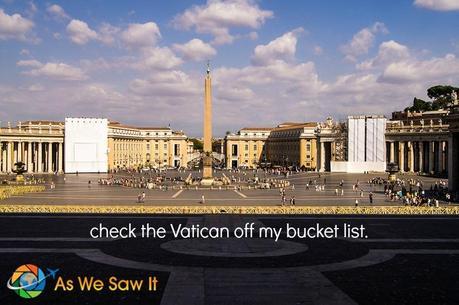 Let’s play “Word Association.” When I say Vatican, what’s the first thing you think of?
Let’s play “Word Association.” When I say Vatican, what’s the first thing you think of?
I’ll bet it has something to do with Catholicism. And why wouldn’t it? Vatican City is the official residence of the pope and the spiritual and administrative center of the Roman Catholic Church.
Three cities in seven days
We were in Italy for one week with a plan to squeeze Rome, Florence, and Venice into that time. Of the three, Rome was definitely the biggest challenge in planning our itinerary. I mean, is it even possible to squeeze 2000 years of history into that time?
Our final itinerary included two days in Rome and one in the Vatican. With all the history, art and culture in both of these places, we had a lot to fit into a little bit of time. I think we did pretty well, though we didn’t try to see the Pope.
Lots of folks have a Vatican City bucket list, even people who aren’t Catholic. Catholic or not, if you add the Vatican to your list of places to see before you die, you won’t be disappointed. Even if you only have one day available.
Here are a few items to add to your own bucket list. Just remember: When you check them off, be sure you are wearing comfortable shoes. You’ll be doing a whole lot of walking!
1. Visit Vatican City

St. Peter’s Square as seen from the porch of the Basilica.
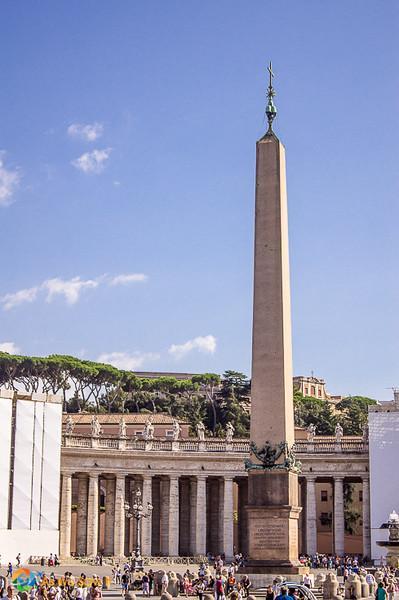
This 4000-year-old obelisk has stood on this site since the 1st century.
It might look like just another district of Rome on the map, but when you enter Vatican City you have officially left Italy! With a microscopic population (fewer than 1000) and only taking up 110 acres of global real estate, Vatican City actually qualifies as the smallest independent country on the planet.
Think of it: You can see an entire country in only a few hours, no visa needed! How cool is that?!
As an independent nation, though, they have their own unique set of rules. Besides passing through the normal security lines, they also screen visitors to ensure they are “dressed in a way befitting entrance to a holy place.” While it is unlikely anyone will have a problem walking around St. Peter’s Square in skimpy clothing, they will turn anyone away at the door who they deem is not suitably dressed.
And of course, as in other places, you should be prepared to leave backpacks and bags with security if asked.
Vatican dress code in a nutshell
- Remove hats indoors.
- Shoulders must be covered. No sleeveless tops or halters. A scarf/pashmina is acceptable as a cover up.
- Knees must be covered. No cut-offs or short skirts. No shorts, either.
Tip: If the thought of wearing pants in hot weather is unbearable, wear zip-off pants (the ones that convert to shorts with zippers around the knees) and bring along those lower legs.
2. See St. Peter’s Basilica
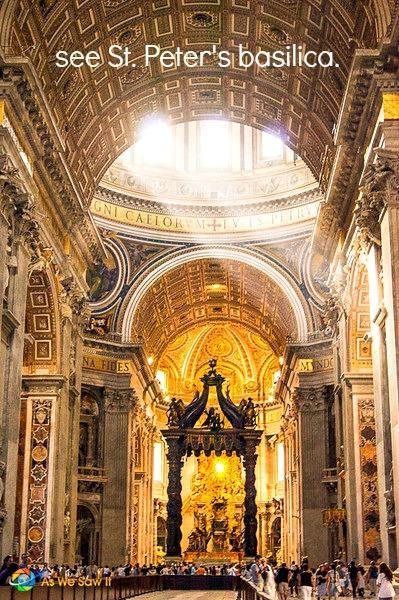
St. Peter’s Baldachin, designed by Bernini, is 10 stories tall.
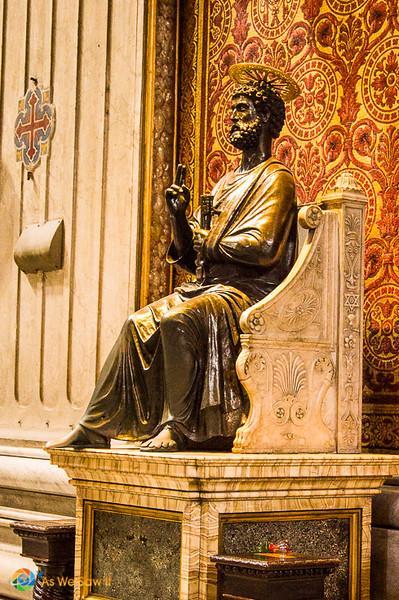
Statue of St. Peter in the Basilica, feet worn by centuries of devotion.
St. Peter’s Basilica is a pilgrimage site for many Catholics. There has been a church on this site since the time of Roman Emperor Constantine the Great. This is the second church, built in the 1500s to replace the 4th century Old St. Peter’s Basilica. Today, St. Peter’s is the largest and one of the best known churches in the world.
The original basilica was built over the historical site of the Circus of Nero, where the Romans martyred thousands of Christians in the first century. According to ancient writers, Jesus’ disciple Peter and many other well-known Christian leaders were martyred here. (Paul was also martyred in Rome but not here.)
The high altar of the basilica was very deliberately centered over the spot where Peter is said to have been buried.
3. Tour the Vatican Museums
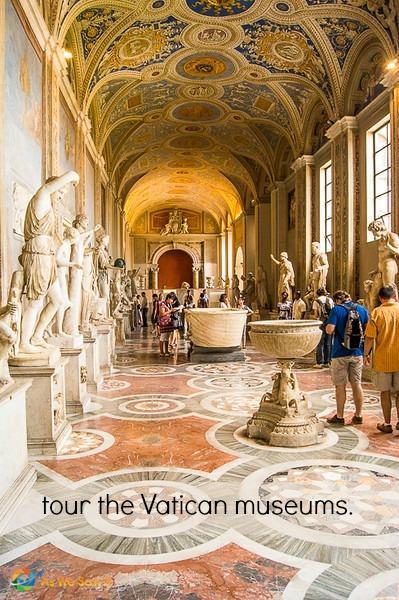
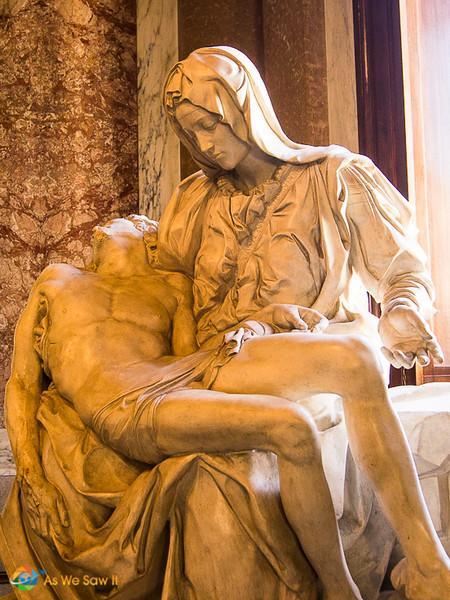
Pieta by Michelangelo, in the Vatican Museums
Pope Julius II was the patron of Michelangelo, Bramante and Raphael as well as of Bernini, the architect responsible for St. Peter’s Basilica. Ever since then popes have collected art, and now the Catholic Church actually owns some of the best-known classical sculptures and masterpieces of Renaissance art in the world.
The same Pope Julius needed a place to house all of his treasures and founded the Vatican Museums in the early 16th century. It now ranks as the 5th most visited art museum in the world.
I would go back there in a heartbeat. It was amazingly impressive despite that we only had time to view a tiny fraction of the works on display. I say “on display” because there’s only enough room to show a portion of what the Vatican holds. After we left I learned that most rooms aren’t open, but some can be viewed. So the next time we go we are going to request a guided tour of the Hidden Vatican Museums, areas of the Museum normally closed to the public.
Admission: General tickets are €16,00 and include entry to the Sistine Chapel. Guided tours are also available. Either way, get exclusive access and skip the long line by buying your ticket online ahead of time.
Avoid visiting on the last Sunday of the month if you can. Entry is free and the museums are so crowded that it’s hard to see anything at leisure.
4. See the Sistine Chapel
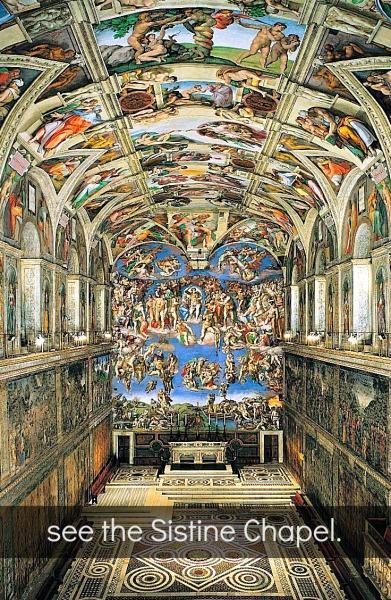
Don’t expect to take your camera into the Sistine Chapel and snap your own photo of the Almighty reaching out to touch Adam’s finger. Absolutely no photography or video is permitted in the room.
The reason is not so that they can protect their precious frescoes from flash damage. Nope. Not at all.
When the Vatican decided to restore Michelangelo’s frescoes back in 1980, the price tag was so high that they had to seek outside funding for the project. The highest bidder was Nippon Television Network Corporation of Japan. In return for funding the $4.2 million project they received the exclusive rights to photography and video of the restored art.
Interestingly, Nippon’s exclusivity expired three years after the Sistine Chapel’s restoration was completed. It seems to me that the current “no photos” rule does little more than encourage purchases from the museum gift shop.
Or am I just being cynical?
Admission: Included with Vatican Museum ticket.
5. Tour the Scavi
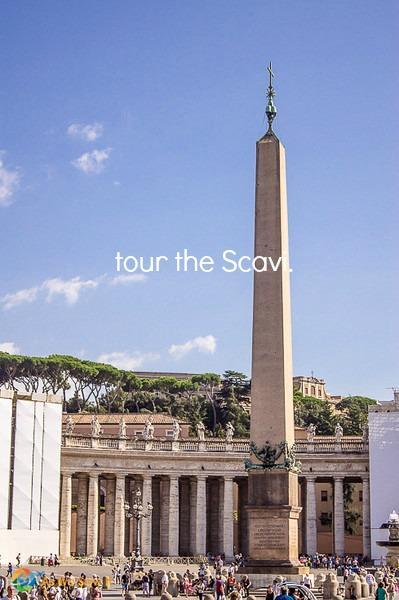
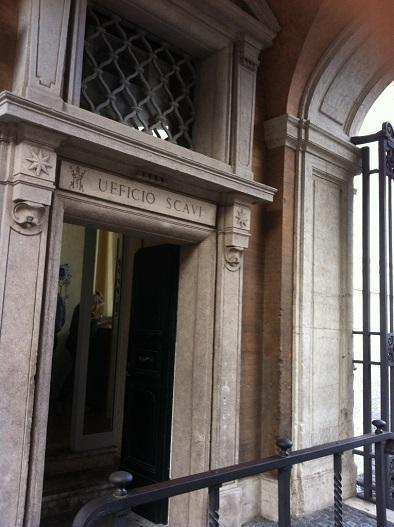
No photos allowed inside.
We are so glad we did this tour. It was the highlight of our entire Vatican experience.
Under St. Peter’s Basilica is a first century necropolis known as the “Scavi,” where St. Peter is said to be buried. It is possible to visit with special permission granted from time to time by the “Fabbrica di San Pietro.”
Only around 250 visitors are permitted to tour the necropolis per day, due to the tight spaces and in order to limit traffic and temperature and humidity levels.
- Visitors must be over 15 years old – no exceptions.
- The guided tour lasts about 1½ hours.
- No cameras of any type are permitted.
- This is not something you should attempt if you have difficulty with stairs or tight spaces.
- You must request a reservation ahead of time. If your requested time is available they will require payment immediately. See the official Vatican Scavi website for details.
6. Meet a Swiss Guard.
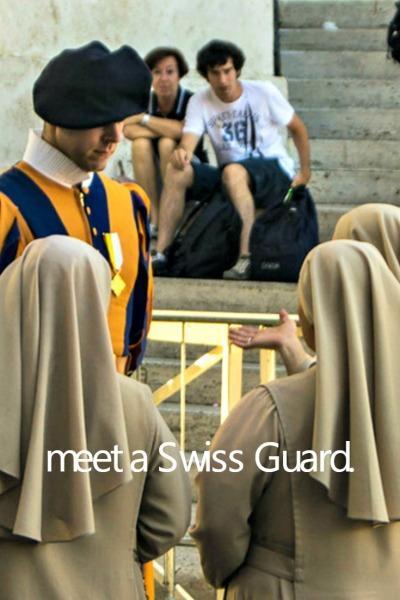
Don’t let the frou-frou of those vibrant Renaissance uniforms fool you: Every Swiss Guardsman has been in the Swiss army, which means they are well trained in firearms and martial arts. Swiss Guards have such a stellar reputation that they have been protecting the Pope and the Apostolic Palace since 1506.
Even when they are on tourist duty you’ll find them outfitted with medieval halberds (a spear-axe combo), swords and pikes. It might not seem very threatening but believe me, those ancient weapons aren’t just for show. Every Swiss guardsman is well trained in each one and won’t be afraid to use it, so don’t try any funny business or you may find yourself at the wrong end of a 9-foot pike.
To be a Swiss Guard you must be single, Swiss, Catholic, male, aged 19-30, former the Swiss military and of excellent conduct and reputation. Those who are accepted get great benefits: 1300 Euros per month (about $1600) plus overtime. They pay no tax, get free accommodation, and eat free, good Swiss-Italian food cooked by Polish sisters. Their tour of duty lasts for two years.
The Swiss Guard are quite serious about their duties. In May 1527 the army of Emperor Charles V stormed Rome. Heavily outnumbered, the Swiss Guards fought the army on the steps of the High Altar of the Vatican while the Pope escaped through a secret passage to the Castel Sant’Angelo. Only 42 of the 189 Swiss Guards survived, but the Pontiff was saved.
As for meeting a Swiss Guardsman, they will talk to you, but don’t expect them to be tour guides or pose for photos. They won’t let anything stand in the way of duty.
7. See the Pope

If you can get to Rome, it’s easy to see the Pontiff (if you’re dressed appropriately). He speaks to the crowds twice a week whenever he is in town.
Here’s how to see the Pope
Wednesdays – 10:30 AM
- General Audiences last for about 2 hours.
- You will need a ticket. TICKETS ARE ALWAYS FREE but must be requested and picked up ahead of time.
Tip: Seats are on a first-come, first-served basis. Arrive 3 hours early to get a good seat. With no ticket, if the Pope is holding audience outdoors, there is always standing room at the back of the Square.
Sundays – 12 noon
- On Sundays he appears in his apartment window on St. Peter’s Square and speaks for around 15-20 minutes.
- Sundays, he gives a short speech, recites the Angelus and ends with the Apostolic Blessing. He may also greet the crowds in various languages.
- You DO NOT need tickets for the Sunday Angelus.
For the Pope’s current schedule and details on getting an audience ticket, see the Vatican’s official page.
Click for more practical information and details about visiting Vatican sites.
The United Nations Educational, Scientific and Cultural Organization (UNESCO) has designated certain places in the world as of outstanding cultural or natural importance to humanity.
Read more about why Vatican City is a UNESCO Site on their website.
Or if you prefer, enjoy our stories about the UNESCO sites we have visited.
(Visited 3 times, 1 visits today)

